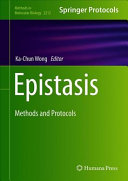Epistasis Methods and Protocols 1st Edition by Ka Chun Wong ISBN 1071609467 9781071609460
$50.00 Original price was: $50.00.$25.00Current price is: $25.00.
Epistasis Methods and Protocols 1st Edition by Ka Chun Wong – Ebook PDF Instant Download/Delivery: 1071609467 ,9781071609460
Full download Epistasis Methods and Protocols 1st Edition after payment

Product details:
ISBN 10: 1071609467
ISBN 13: 9781071609460
Author: Ka Chun Wong
This volume explores methods and protocols for detecting epistasis from genetic data. Chapters provide methods and protocols demonstrating approaches to identify epistasis, genetic epistasis testing, genome-wide epistatic SNP networks, epistasis detection through machine learning, and complex interaction analysis using trigenic synthetic genetic array (τ-SGA). Written in the highly successful Methods in Molecular Biology series format, chapters include introductions to their respective topics, application details for both the expert and non-expert reader, and tips on troubleshooting and avoiding known pitfalls.
Authoritative and cutting-edge, Epistasis: Methods and Protocols aims to ensure successful results in the further study of this vital field.
“Simulating Evolution in Asexual Populations with Epistasis” is available open access under a Creative Commons Attribution 4.0 International License via link.springer.com.
Epistasis Methods and Protocols 1st Edition Table of contents:
Chapter 1: Mass-Based Protein Phylogenetic Approach to Identify Epistasis
1 Introduction
2 Methods
2.1 Protein Isolation and Purification
2.2 Protein Digestion
2.3 Peptide Mass Map Generation
2.4 Mass Tree Construction
2.5 Mass Tree Visualization
2.6 Identification of Epistatic Pairs
2.7 Mutation Position Analysis
3 Results
3.1 Application of Mass Tree Analysis to Study Epistasis in Influenza Hemagglutinin
3.2 Conclusion
4 Notes
References
Chapter 2: SNPInt-GPU: Tool for Epistasis Testing with Multiple Methods and GPU Acceleration
1 Introduction
2 Materials
2.1 Installation of SNPInt-GPU Software
2.2 Helper Software
3 Methods
3.1 General Options
3.1.1 Input/Output
3.1.2 Number of Reported Results
3.1.3 Method Selection
3.1.4 Marker Regions
3.1.5 GPU Acceleration
3.2 Pre-filtering for QC
3.2.1 Data Cleaning
3.2.2 LD-pruning
3.3 Logistic-Regression Based Epistasis Testing
3.4 Epistasis Screening with BOOST
3.5 Entropy-Based Measures
3.5.1 Mutual Information
3.5.2 Information Gain
3.6 LD Calculation On-the-Fly
3.7 Result Post-processing
3.7.1 Different Sort Order
3.7.2 Q-Q Plot
3.8 Runtime Examples
4 Notes
References
Chapter 3: Epistasis-Based Feature Selection Algorithm
1 Introduction
2 Materials
2.1 Dataset 1
2.2 Dataset 2
3 Methods
3.1 Retrieving the Data
3.2 Using Some Scientific Software
3.3 Implementation Details
3.3.1 EbFSA Version 1
3.3.2 EbFSA Version 2
4 Notes
References
Chapter 4: W-Test for Genetic Epistasis Testing
1 Introduction
2 Materials
2.1 Genotype Data
2.2 Genotype-Methylation Data
2.3 R Software
3 Method
3.1 Design
3.2 Analysis of Genotype Data
3.2.1 Detection of the Main Effect
3.2.2 Detection of Second-Order Interaction
3.2.3 Detection of Higher-Order Interaction
3.3 Analysis of Gene-Methylation Interaction
3.4 Diagnostic Checking
4 Notes
References
Chapter 5: The Combined Analysis of Pleiotropy and Epistasis (CAPE)
1 Introduction
2 Materials
2.1 Genotypes
2.2 Covariates
2.3 Traits
2.4 Parameter File
3 Methods
3.1 Decompose Traits to Eigentraits
3.2 Correct for Kinship
3.3 Select Markers for Pairwise Testing
3.4 Linear Regression on Pairs
3.5 Infer Interactions Through Combined Analysis of Pleiotropy and Epistasis
4 Notes
References
Chapter 6: Two-Stage Testing for Epistasis: Screening and Verification
1 Introduction
2 Methods
2.1 Problem Setup and Notation
2.1.1 Logistic Regression Model for Interaction
2.1.2 Multiple Testing
2.2 The Basic Principles of Two-Stage Testing
2.2.1 Formal Two-Stage Testing Procedure
2.2.2 Type I Error Control in Two-Stage Procedures
2.3 Two-Stage Methods for Epistasis
2.3.1 Obtaining Independent Tests
2.3.2 Linkage Disequilibrium: A Key to Screening for Epistasis
2.3.3 Methods via Approach A: (Nearly) Independent Test Statistics
Method 1: Pre-testing for Main Effects
Method 2: Pre-testing Using Pooled-Sample χ2-test
2.3.4 Method via Approach B: Disjoint Data Method
2.3.5 Method via Approach C: Independence Through Regression
2.4 Choice of Input Parameters
2.4.1 Choice of α1 Level
2.4.2 Choice of Interaction Penetrance Model
2.5 Software
3 Final Remarks
References
Chapter 7: Using Collaborative Mixed Models to Account for Imputation Uncertainty in Transcriptome-Wide Association Studies
1 Introduction
2 Materials
2.1 Software
2.2 eQTL Data
2.3 GWAS Data
2.3.1 Individual-Level GWAS Data
2.3.2 Summary-Level GWAS Data
3 Methods
3.1 Selection of the Target Tissue
3.2 Genotype Quality Control in eQTL
3.3 Formatting Gene Expression in eQTL
3.4 Formatting GWAS Data
3.4.1 Formatting GWAS Individual Data
3.4.2 Formatting GWAS Summary Statistic Data
3.5 Testing for Association
3.5.1 GWAS Individual-Level Data
3.5.2 GWAS Summary Statistics
3.6 Multiple Hypothesis Testing
3.7 Post Analysis
4 Notes
References
Chapter 8: Phenotype Prediction Under Epistasis
1 Introduction
2 Methods
2.1 Genomic Best Linear Unbiased Prediction (GBLUP)
2.2 Epistatic Random Regression BLUP (ERRBLUP)
2.3 Selective Epistatic Random Regression BLUP (sERRBLUP)
3 Notes
References
Chapter 9: Simulating Evolution in Asexual Populations with Epistasis
1 Introduction
2 Methods
2.1 Installing and Loading OncoSimulR
2.2 Specifying Epistasis
2.2.1 Specifying Epistasis Indirectly: Explicit Mapping from Genotypes to Fitness
2.2.2 Specifying Epistasis Indirectly: Using Models for Fitness Landscapes
2.2.3 Specifying Epistasis Directly: Genes Without Interactions (No Epistasis)
2.2.4 Specifying Epistasis Directly: Two Alternative Specifications of Epistasis
2.2.5 Two Alternative Specifications of Epistasis: A Three-Gene Example
2.2.6 Synthetic Viability
2.2.7 Synthetic Sickness, Synthetic Lethality or Synthetic Mortality
2.3 Simulating Evolution
2.3.1 Growth Models
2.3.2 Mutation Rates, Mutator Genes
2.3.3 Running Simulations Until Pre-specified Conditions Are Met
2.3.4 Fixation of Genes and Gene Combinations
2.3.5 Fixation of Genotypes
2.3.6 Fixation: Tolerance, Number of Periods, Minimal Size
2.3.7 Stochastic Detection Mechanism
3 Output and Data Analysis
4 Notes: Potential Pitfalls and Troubleshooting
References
Chapter 10: Protocol for Construction of Genome-Wide Epistatic SNP Networks Using WISH-R Package
1 Introduction
2 Materials
2.1 Genotype Data in PED and Map Files
2.2 Phenotype Data
3 Methods
3.1 Install WGCNA and WISH-R Packages
3.2 Reduce Genotype Data Dimensionality and Generate Genotype Matrix
3.3 Run Genome-Wide Epistatic Analyses
3.4 Generate SNP Modules (of Interacting Epistatic SNPs)
3.5 Visualize Genome-Wide Epistatic Interactions in HeatMap and Chromosomes
4 Notes
References
Chapter 11: Brief Survey on Machine Learning in Epistasis
1 Introduction to Epistasis Biology
1.1 Machine Learning and Epistasis
2 Applications
3 Discussion
References
Chapter 12: First-Order Correction of Statistical Significance for Screening Two-Way Epistatic Interactions
1 Introduction
1.1 Problem
1.2 Available Solution
1.3 Proposed Solution
1.4 Summary
2 Materials
3 Methods
4 Notes
References
Chapter 13: Gene-Environment Interaction: A Variable Selection Perspective
1 Introduction
2 Method
2.1 The Two Paradigms: Marginal and Joint Analysis
2.1.1 Marginal Analysis-Based Variable Selection
2.1.2 Joint Analysis-Based Variable Selection
2.2 The Form of Environmental Factors
2.3 Other Important Considerations
2.4 Marginal Analysis
2.4.1 Statistical Significance-Based Marginal Studies
2.4.2 Penalization-Based Marginal Studies
Remarks on the Choices of Penalty Functions Under Model (Eq. 4)
2.5 Joint Analysis
2.5.1 Statistical Significance-Based Joint Studies
Remarks on a Unified Framework of Varying Index Coefficient Models
2.5.2 Penalization-Based Joint Studies
Remarks on the Choices of Penalty Functions Under Model (Eq. 6)
Remarks on the Choices of Penalty Functions Under Model (Eq. 7)
2.6 Computational Aspects in G x E Studies
3 Notes
References
Chapter 14: Using C-JAMP to Investigate Epistasis and Pleiotropy
1 Introduction
2 Materials
2.1 Assumed Biological Model with Epistasis and Pleiotropy
2.2 Statistical Model of C-JAMP
2.3 Implementation of C-JAMP
2.4 UK Biobank
3 Methods
3.1 Preprocessing of the UK Biobank Data
3.2 Analysis of Epistasis and Pleiotropy Using C-JAMP
4 Notes
References
Chapter 15: Identifying the Significant Change of Gene Expression in Genomic Series Data for Epistasis Peaks
1 Introduction
2 Methods
2.1 Required Software
2.2 Implementation
2.2.1 Initialization
2.2.2 Peak Detection
2.2.3 Gene Co-expression Analysis
2.2.4 Identification of Biomarker Clusters with Similar Gene Regulation
2.2.5 Plotting the Selected Biomarkers in a Heatmap
3 Notes
3.1 Peak Detection
3.2 k-Means Clustering
3.3 Hierarchical Clustering
3.4 DBSCAN Clustering
References
Chapter 16: Analyzing High-Order Epistasis from Genotype-Phenotype Maps Using `Epistasis ́ Package
1 Introduction
2 Materials
2.1 Data and Code Availability
3 Methods
3.1 High-Order Epistasis Modeling in the “Epistasis ́ ́ Package
3.2 A Step-by-Step Guide to the Application of the “Epistasis ́ ́ Package
3.2.1 Installation of the Package
3.2.2 Importing Genotype-Phenotype Data from JSON File
3.2.3 Modeling Non-linear Scale by Regression Models
3.2.4 Visualization of Non-linear Scale and Coefficients of Epistasis
4 Notes
References
Chapter 17: Deep Neural Networks for Epistatic Sequence Analysis
1 Introduction
2 Methods
2.1 Software Requirement
3 Application of Pysster to the RNA A-to-I Editing Region Classification
3.1 Load the RNA Editing Dataset to be Used for Model Training, Testing and Evaluation
3.2 Train a Convolutional Neural Network for Sequence Classification
3.3 Perform Grid Search to Optimize the Hyper-parameters of the Model
3.4 Classify RNA Editing Sequences
3.5 Performance Evaluation
3.6 Visualization and Interpretation of the Convolutional Neural Network
3.7 Visualization of Co-occurring Motifs
3.8 Save the Model and Preditive Motifs
4 Application of Pysster to an Artificial Epistatic Sequence Dataset
References
Chapter 18: Protocol for Epistasis Detection with Machine Learning Using GenEpi Package
1 Introduction
2 Materials
3 Methods
3.1 Data Preprocessing
3.2 Stage 1
3.3 Stage 2
4 Notes
References
Chapter 19: A Belief Degree-Associated Fuzzy Multifactor Dimensionality Reduction Framework for Epistasis Detection
1 Introduction
2 Materials
3 Methods
3.1 Epistasis Detection
3.2 FSMDR
3.3 Experimental Setup and Results of FSMDR
3.4 Proposed Belief Degree-Associated FSMDR
4 Notes
References
Chapter 20: Epistasis Detection Based on Epi-GTBN
1 Introduction
2 Methods
2.1 Required Software
2.2 Installation
2.3 Input Data Format
2.4 Application of Epi-GTBN
3 Conclusion
References
Chapter 21: Epistasis Analysis: Classification Through Machine Learning Methods
1 Introduction
2 Data Description and Preprocessing
2.1 Dataset Description
2.2 Data Preprocessing
3 Methodology
3.1 Cross-Validation
3.2 Feature Selection
3.3 Classification
3.4 Evaluation of Model
3.4.1 Confusion Matrix
3.4.2 Evaluation Index
References
Chapter 22: Genetic Interaction Network Interpretation: A Tidy Data Science Perspective
1 Introduction
2 Materials
2.1 R Installation and Relevant Packages Installed from Bioconductor, CRAN, and GitHub
2.2 Genetic Interactions in Humans Obtained from BioGRID
2.3 Gene Expression in the Human Tissues Obtained from GTEx
3 Methods
3.1 Identifying and Interpreting Network Modules of Genetic Interactions in Human
3.2 Identifying and Interpreting Tissue-Specific Genetic Interactions Through Integrative Analysis
3.3 Tissue Clustering and Differential Analysis in the Light of Genetic Interactions
4 Notes
References
Chapter 23: Trigenic Synthetic Genetic Array (τ-SGA) Technique for Complex Interaction Analysis
1 Introduction
2 Materials
2.1 Media and Stock Solutions
2.2 Additional Random Spore Media
2.3 Strains, Plasmids, and Primers
2.4 High-Throughput Robotic Equipment and Accessories
2.5 Medium-Throughput Robotic Equipment and Accessories
3 Methods
3.1 Query Strain Construction
3.1.1 Nonessential Gene Deletion Mutant SGA Query Strain Construction by PCR-Mediated Gene Deletion
3.1.2 Conditional Allele of Essential Gene Mutant SGA Query Strain Construction by Two-Step PCR-Mediated Integration
3.2 Sterilization Procedure for Robotic Pin Tools of BioMatrix Robot
3.3 Array Strain Construction
3.4 τ-SGA Procedure
3.5 Confirming Genetic Interactions
3.6 Quantitatively Scoring Digenic and Trigenic Interactions Using Colony Size as a Proxy for Fitness
3.7 Analysis Tools for Trigenic Interactions Data
4 Notes
References
Index
People also search for Epistasis Methods and Protocols 1st Edition:
epistasis simple
epistasis simple terms
epistasis simple definition biology
epistasis simple definition
reciprocal recessive epistasis ratio
Tags: Ka Chun Wong, Epistasis Methods, Protocols
You may also like…
Engineering - Chemical Engineering
Chemical Engineering Thermodynamics I 6th Edition by KA Gavhane ISBN 9380064667 9789380064666
Arts - Performing Arts
Theatre Criticism Changing Landscapes 1st Edition Duška Radosavljevic
Physics - Quantum Mechanics
An Introduction to Covariant Quantum Mechanics 1st Edition Josef Janyška
Uncategorized
Computers - Networking
Uncategorized
Medicine - Pediatrics
Education Studies & Teaching
Assessment for Experiential Learning 1st Edition Cecilia Ka Yuk Chan











